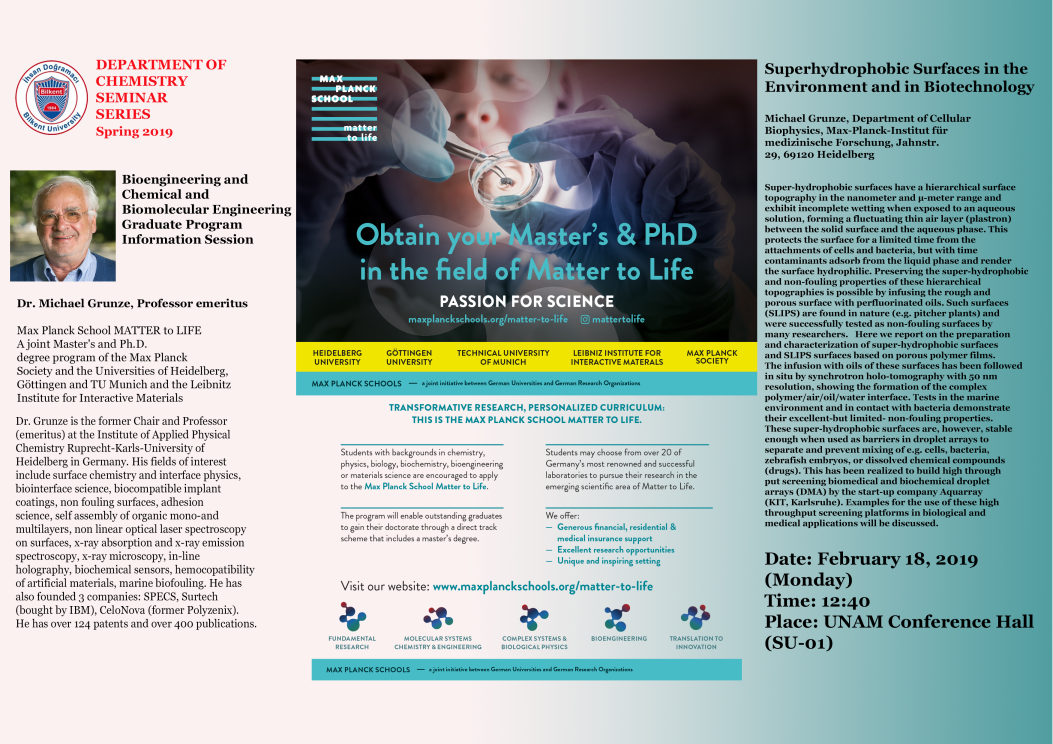Spring '19 Department Seminars with Prof. Michael Grunze
Title: Superhydrophobic Surfaces in the Environment and in Biotechnology
Speaker: Prof. Michael Grunze
Department of Cellular Biophysics, Max-Planck Institute for Medical Research,
Heidelberg, Baden-Württemberg, Germany
Date: February 18, 2019
Time: 12:40
Place: UNAM Conference Hall (SU-01)

Abstract:
Super-hydrophobic surfaces have a hierarchical surface topography in the nanometer and μ-meter range and exhibit incomplete wetting when exposed to an aqueous solution, forming a fluctuating thin air layer (plastron) between the solid surface and the aqueous phase. This protects the surface for a limited time from the attachments of cells and bacteria, but with time contaminants adsorb from the liquid phase and render the surface hydrophilic. Preserving the super-hydrophobic and non-fouling properties of these hierarchical topographies is possible by infusing the rough and porous surface with perfluorinated oils. Such surfaces (SLIPS) are found in nature (e.g. pitcher plants) and were successfully tested as non-fouling surfaces by many researchers. Here we report on the preparation and characterization of super-hydrophobic surfaces and SLIPS surfaces based on porous polymer films.
The infusion with oils of these surfaces has been followed in situ by synchrotron holo-tomography with 50 nm resolution, showing the formation of the complex polymer/air/oil/water interface. Tests in the marine environment and in contact with bacteria demonstrate their excellent-but limited- non-fouling properties. These super-hydrophobic surfaces are, however, stable enough when used as barriers in droplet arrays to separate and prevent mixing of e.g. cells, bacteria, zebrafish embryos, or dissolved chemical compounds (drugs). This has been realized to build high throughput screening biomedical and biochemical droplet arrays (DMA) by the start-up company Aquarray (KIT, Karlsruhe). Examples for the use of these high throughput screening platforms in biological and medical applications will be discussed.
Short Biography of the Speaker:
Dr. Grunze is the former Chair and Professor (emeritus) at the Institute of Applied Physical Chemistry Ruprecht-Karls-University of Heidelberg in Germany. His fields of interest include surface chemistry and interface physics, biointerface science, biocompatible implant coatings, non fouling surfaces, adhesion science, self assembly of organic mono-and multilayers, non linear optical laser spectroscopy on surfaces, x-ray absorption and x-ray emission spectroscopy, x-ray microscopy, in-line holography, biochemical sensors, hemocopatibility of artificial materials, marine biofouling. He has also founded 3 companies: SPECS, Surtech (bought by IBM), CeloNova (former Polyzenix). He has over 124 patents and over 400 publications.